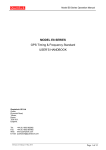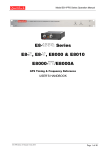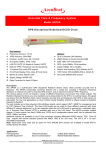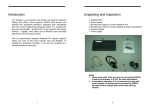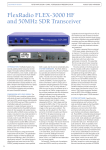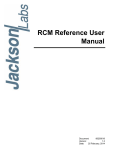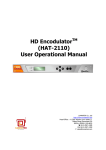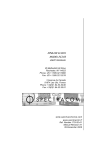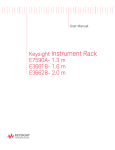Download Manual
Transcript
Model E8000 Series Operation Manual MODEL E8000 SERIES GPS Timing & Frequency Standard USER’S HANDBOOK Quartzlock UK Ltd Gothic, Plymouth Road, Totnes, Devon TQ9 5LH, England. Tel: Fax: Web: E-mail: +44 (0) 1803 862062 +44 (0) 1803 867962 www.quartzlock.com [email protected] E8000 Series A5 Manual 9 October 2008 Page 1 of 12 Model E8000 Series Operation Manual Contents Safety Considerations.......................................................................................................... 3 Voltage, Frequency and Power Characteristics ................................................................... 4 Environmental Conditions .................................................................................................... 4 Replaceable Fusing Characteristics .................................................................................... 4 Cleaning Instructions ........................................................................................................... 4 E8 Series GPS Timing & Frequency Reference .................................................................. 5 Introduction ...................................................................................................................... 5 Installation ........................................................................................................................ 5 Operation ......................................................................................................................... 5 Interface and programming .............................................................................................. 6 GPS interface ............................................................................................................... 6 Specifications ................................................................................................................... 8 OUTPUTS: ................................................................................................................... 8 Appendix A ..................................................................................................................... 10 Board set up ............................................................................................................... 10 Appendix B ..................................................................................................................... 11 RS232 control codes .................................................................................................. 11 E8000 Series A5 Manual 9 October 2008 Page 2 of 12 Model E8000 Series Operation Manual Safety Considerations General This product and related documentation must be reviewed for familiarisation before operation. If the equipment is used in a manner not specified by the manufacturer, the protection provided by the instrument may be impaired. Before Applying Power Verify that the product is set to match the available line voltage and the correct fuse is installed. Before Cleaning Disconnect the product from operating power before cleaning. WARNING Bodily injury or death may result from failure to heed a warning. Do not proceed beyond a warning until the indicated conditions are fully understood and met. CAUTION Damage to equipment, or incorrect measurement data, may result from failure to heed a caution. Do not proceed beyond a caution until the indicated conditions are fully understood and met. This equipment must be earthed An uninterruptible safety earth ground must be maintained from the mains power source to the product’s ground circuitry. WARNING When measuring power line signals, be extremely careful and use a step down isolation transformer whose output is compatible with the input measurement capabilities of this product. The product’s front and rear panels are typically at earth ground. Thus, never try to measure AC power line signals without an isolation transformer. WARNING Instructions for adjustments when covers are removed and for servicing are for use by servicetrained personnel only. To avoid dangerous electrical shock, do not perform such adjustments or servicing unless qualified to do so. WARNING Any interruption of the protective grounding conductor (inside or outside the instrument) or disconnecting of the protective earth terminal will cause a potential shock hazard that could result in personal injury. Grounding one conductor of a two conductor out-let is not sufficient protection. Whenever it is likely that the protection has been impaired, the instrument must be made inoperative and be secured against any unintended operation. If the instrument is to be energised via an autotransformer (for voltage reduction) makes sure the common terminal is connected to the earthed pole terminal (neutral) of the power source. Instructions for adjustments while the covers are removed and for servicing are for use by servicetrained personnel only. To avoid dangerous electrical shock, do not perform such adjustments or servicing unless qualified to do so. E8000 Series A5 Manual 9 October 2008 Page 3 of 12 Model E8000 Series Operation Manual For continued protections against fire, replace the line fuse(s) with fuses of the same current rating and type (for example, normal blow time delay). Do not use repaired fuses of short-circuited fuse holders. Voltage, Frequency and Power Characteristics AC Power Adaptor Voltage 100-240V AC Frequency 40-50Hz Power characteristics 500mA Max Voltage 12V dc 300mA – 500mA Environmental Conditions Temperature Operating (ambient) -10°C to +55°C (-65 to +65 op) Storage -40°C to +85°C Magnetic Field Sensitivity ≤2x10-11/ Gauss Atmospheric Pressure -60m to 4000m <1x10-13/ mbar Replaceable Fusing Characteristics N/A Cleaning Instructions To ensure long and trouble operation, keep the unit free from dust and use care with liquids around the unit. Be careful not to spill liquids onto the unit. If the unit does get wet, turn the power off immediately and let the unit dry completely before turning it on again. Clean with a damp (with water) cloth. Never spray cleaner directly onto the unit or let liquid run into any part of it. Never use harsh or caustic products to clean the unit. E8000 Series A5 Manual 9 October 2008 Page 4 of 12 Model E8000 Series Operation Manual E8 Series GPS Timing & Frequency Reference Introduction The GPS clock is shipped ready for operation. No adjustments are needed to have a 10MHz frequency reference and 1 pulse per second time reference within 20 minutes of initial switch on. The status of the GPS lock is shown on four LEDs on the front panel. For more information as to satellite signal strengths, etc, a computer with RS232 may be connected to the interface. A freeware program such as WinOncore may be used to display information from the GPS receiver. Installation The antenna should be installed, preferably with a 360 degree view of the sky. The GPS receiver uses the Motorola TRAIM algorithm and after the site survey uses all the tracked satellites to calculate the time solution. If the TRAIM limit is exceeded (set by default to 300ns) the receiver will go into holdover. Thus the best possible antenna positioning should be used. The receiver is very sensitive and will give good results with the antenna on a window ledge, or even inside a building, however if the holdover state occurs, the antenna position should be improved. The satellite signal strengths may be checked after installation using a computer with suitable software connected to the RS232 interface. Operation The unit is fully programmed to operate without adjustment anywhere in the world. The GPS receiver is held in reset until the rubidium reference has warmed up and locked. During this time the GPS LEDs (green and amber) will be off. After about 5 minutes the GPS receiver will start looking for satellites. It will take about 1 minute to obtain a fix from a cold start with unknown location. The receiver then does a "site survey" for about 15 minutes, averaging the positions obtained. After the site survey is complete, the receiver switches to position hold mode, and uses all the satellites available to improve the accuracy of the time calculation. At this point the unit will start to lock its rubidium reference oscillator to the GPS signal. This will take up to 30 minutes. When the PLL locks the red "lock" LED should go out, but may flash (flash of 0.1seconds) for a further 10 minutes as the PLL settles. The normal operating condition is with the red "lock" LED off. The status of the satellite tracking is shown by the green and amber LEDs. The normal situation is that the green LED shows a long flash, followed by a number of short flashes. The number of short flashes shows the number of satellites being tracked, and included in the time solution. The amber LED may also flash. This shows the number of satellites being tracked, but not included in the timing solution. If the red "lock" LED should start to flash (flash of 0.1seconds) at about 1Hz rate, this indicates that the phase error between the GPS signal and the reference oscillator is greater than a preprogrammed threshold. This does not indicate that the 10MHz output is unlocked. During normal operation the GPS receiver estimates the accuracy of the timing solution using the "TRAIM" algorithm (Time Receiver Autonomous Integrity Monitoring) developed for the Motorola Oncore receiver. If the predicted timing error is greater than the programmed limit, the receiver will switch into holdover mode, and the red lock LED will start to flash at a 2Hz rate with equal mark space ratio, i.e. on for 1 second, off for 1 second. The 10MHz output and 1pps output will then drift according to the ambient temperature and aging of the rubidium oscillator. When the GPS receiver E8000 Series A5 Manual 9 October 2008 Page 5 of 12 Model E8000 Series Operation Manual comes out of standby, the 1PPS output will immediately revert to full accuracy. The 10MHz output may require a period to settle. The unit should never go into holdover during normal operation. The most likely reason for doing so is a poor antenna location Interface and programming The unit has one RS232 compatible interface. This is shared between the GPS receiver and the microcontroller that locks the 10MHz output to the GPS signal. On Initial switch on the interface is connected to the microcontroller. If no valid interface code is received within 30 seconds, the interface switches over to the GPS receiver. If a valid interface code is received, the interface remains connected to the microcontroller until the next power on reset. GPS interface The GPS receiver interface uses Motorola binary format. In order to use this, a freeware program such as WinOncore should be installed on the user’s PC. Connect the unit to the PC and start the program. It may be necessary to set the port and baud rate (9600). The receiver is preset to output 3 sentences on a continuous basis. These are Ha, (position/status/data), Hn, (12 channel TRAIM status message) and Bb (Visible satellites). The various windows available from the program should show current satellite data, etc. It is important to note that some parameters shown by the program will not correctly indicate the actual state of the receiver. This is because the program does not automatically update its information when started. In particular, the TRAIM algorithm will be shown as off when in fact it is by default on in the receiver. For the receiver to operate correctly, the site survey must be enabled, and the TRAIM must be on. If this is not the case, the receiver will track satellites and compute a fix, but the red lock LED will not go out, showing the 10MHz output is in the standby state. If the receiver gets stuck in a state where it does not lock, the user may inadvertently disabled the TRAIM or the site survey. To get back to a known state, the following should be performed: The messages can be sent using the message window in the WinOncore software. Return to factory default state: "@@Cf" Enable Position Auto-survey; consult the CW12 user manual for further details "@@Gd03" Enable T-RAIM algorithm; consult the CW12 user manual for further details. - "@@Ge01" Set the alarm threshold for the T-RAIM algorithm (300ns). See the CW12 user manual for further details "@@Gf300" Request channel T-RAIM status message (sent every second) "@@Hn01" If required, the position/status/data message may be turned on: "@@Ha01" E8000 Series A5 Manual 9 October 2008 Page 6 of 12 Model E8000 Series Operation Manual If required, the visible satellites message may be switched on: "@@Bb01" The GPS receiver stores the current status in non volatile memory when switched off. Microcontroller Interface The microcontroller interface allows setup and debug of the digital phase lock loop which locks the 20MHz reference oscillator to the GPS receiver. The list of control codes is given in an appendix. The only user adjustable parameter is the PLL bandwidth, which is accessed with command "UA". The band width has been factory set to optimum for the E8-X (TCXO) and the E8-Y (OCXO). It is only recommended that the user adjusts these values if he is able to measure Allen variance of the 10MHz output at averaging times between 1 and 1000 seconds. "UA?" will return the current bandwidth (0 to 7, with 0 the narrowest bandwidth) The second parameter (hex) is the elapsed running time in units of 2.33 hours. E8000 Series A5 Manual 9 October 2008 Page 7 of 12 Model E8000 Series Operation Manual Specifications OUTPUTS: Sine wave, 10MHz, 10dBm ± 2dBm into 50ohms Harmonics < -30dBc Spurii <-75dBc TTL, 3.3VCMOS, 1pulse per second POWER SUPPLY: 90 to 250V AC 250mA – 500mA DPLL tracking bandwidths 10uHz to 1mHz typical in 8 binary increments Default 20mHz LOCK INDICATOR On not locked Off locked, low phase error Short flash every second: locked, high phase error GPS INDICATOR Green: indicates no of satellites used in time solution Amber: indicates no of satellites tracked but not used in time solution INTERFACE Shared between DPLL and GPS receiver DPLL 9.6kbaud, RS232, PC compatible GPS 9.6kbaud, Motorola binary format (8bits no parity, no handshake) INTERFACE CODES See Appendix B TIME DOMAIN STABILITY (10MHz output) Tau 1s 10s 100s 1000s >10000s Allen variance E8000 5x10-11 1x10-10 4x10-11 8x10-12 5x10-12 E8010 5x10-12 3x10-12 2x10-12 1x10-12 1x10-12 JITTER (1PPS output) Typical < 5ns RMS E8000 Series A5 Manual 9 October 2008 Page 8 of 12 Model E8000 Series Operation Manual Phase Noise 1Hz 10Hz 100Hz 1 kHz 10 kHz E8000 E8010 -69dBc -98dBc -120dBc -130dBc -140dBc -100dBc -120dBc -140dBc -145dBc WARMUP < 25 minutes to specified accuracy E8000 Series A5 Manual 9 October 2008 Page 9 of 12 Model E8000 Series Operation Manual Appendix A Board set up Links SP1 Leave open circuit, Used to upload new firmware to the CW25 GPS module. SP2 Leave open circuit for 3.3V antenna power. Link (default) for 5V antenna power. SP3 Link only when 5V OCXO is fitted. SP4 Leave open circuit when U5 (enhanced voltage reference) is used. Link when U5 is not fitted to board. JP2, 5, 7 fit all jumpers with shorting links for normal operation. Links must be removed when programming U5 from the Microchip ICD-2 programmer. U5 should be powered from the programmer when programming. This is necessary as U5 cannot be programmed with 3.3V Vdd. JP6 Link for normal operation. Tune Voltage Span The tune voltage span should be set using the microcontroller interface to suit the tuning range of the controlled oscillator. For detailed procedure please refer to manufacturer. E8000 Series A5 Manual 9 October 2008 Page 10 of 12 Model E8000 Series Operation Manual Appendix B RS232 control codes (All values following command or returned from the microcontroller are hexadecimal) * = backed up in EEPROM UA OS User adjust UA? Returns user parameters aa bbbb cccc * aa is bandwidth control: bits set: bit0, 1, 2: bandwidth (0 to 7) * bbbb is clock registers 3 and 4 (elapsed time) * cccc is maximum slew rate of tuning voltage UABaa Write new bandwidth control byte UAScccc write new maximum slew rate Overall Status OS? Returns overall status bytes: aa bb cc dddd ee ffff * aa is test status byte: Bits set: bit0, 1, 2: bit3: bit4: bit5: bit6: bit7: Bits 2, 1, 0: bb cc dddd * 000 001 010 011 100 101 110 111 is lock status byte: Bits set bit0 to 2: bit3: bit4: bit5: bit6: bit7: is second lock status byte: Bits set bit0 Bit1 Bit2 is PLL control: Bits set bit0, 1, 2, 3 bit4, 5, 6, 7 bit8, 9, 10, 11 bit12, 13, 14, 15 ee is reference tune span ffff is OCXO current (filtered) bits 0 to 2 DAC output select no integrator update no proportional term Inhibit holdover mode NU inhibit state control no test output, fine tune DAC used for tuning sub sampled I sub sampled Q PLL Integrator upper 16 bits Phase result I sample (filtered) Q sample (filtered) references CH6 (filtered) State control, states 0 to 7 set to normalise tuning DACs (cleared automatically) OCXO warmed up Loop locked narrow range phase detector in use set to inhibit auto load of PLL gain parameters TCXO tune voltage OK Rubidium locked GPS time valid (not in holdover) subsample rate exp filter order integrator gain proportional gain OSTaa Write new test status byte OSLbb Write new lock status byte E8000 Series A5 Manual 9 October 2008 Page 11 of 12 Model E8000 Series Operation Manual PL OSGdddd Write new PLL control OSSee Write new reference tune span Phase lock loop PL? Returns current status of PLL aaaa bbbb cccccccc dddd eeee * PD aaaa bbbb cccccccc dddd eeee last value of I sample (filtered), 2s complement, 16 bit last value of Q sample (filtered), 2s complement 16 bit last value of PLL integrator (32 bit integer) coarse tune DAC 16 bit integer fine tune DAC 16 bit integer PLIcccccccc Write new PLL integrator PLCdddd Write new coarse tune DAC PLFeeee Write new fine tune DAC PL+ Enter command PL? into repeat stack Phase detector PD? Returns phase detector parameters aaaa bbbb cccc dddd eeee aaaa bbbb cccc dddd eeee PD+ Last phase result, 2s complement Last mod[I] +mod[Q] 2.5V reference (filtered) mod (phase result) (filtered) lsb=3.05ps mod(freq offset) (filtered) lsb = 2.33E-14 Write PD? to command repeat stack EU EEPROM Update (backed up values) SR ER Software Reset EEPROM read ERCaabb Returns bb bytes from starting address aa as ASCII characters ERNaabb EW Returns bb bytes from starting address aa as hexadecimal numbers (character pairs) EEPROM write EWCaabbccccc------c Writes bb characters to starting address aa. Correct number of characters must be included in string EWNaabbcccc------c Writes bb bytes to starting address aa. Character pairs cc etc. are interpreted as hexadecimal numbers. RI Repeat Interval RI? Returns command repeat interval aa aa 8 bit command repeat interval multiplier. Range 1 to 255. Command repeat interval is 50ms x aa RI0aa Write new command repeat interval RID Cancel command repeat and clear command repeat stack E8000 Series A5 Manual 9 October 2008 Page 12 of 12













